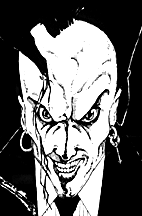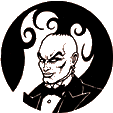| HOME | BOOKS | COMICS | RECORDS | NEWS | PEOPLE | PICTURES | ORDERS | HISTORY | office@savoy.abel.co.uk |
 | Reverbstorm: New Wave Sword & Sorcery b y J o h n C o u l t h a r t Exclusive to this web site (1998) |
 PART OF THE IMPETUS for the Reverbstorm series was to bring Lord Horror's character out of the wartime period and into the present/near future in a more intelligent and powerfully realised manner than had been attempted in the first two Lord Horror comics, a pair of works which should be regarded as little more than sketches for an evolving character. Having been promoted to main artist in the new series (with Kris Guidio providing spot illustrations of Horror and Jessie), David Britton encouraged me to take the cue from the work I'd done in Hard Core Horror No. 5 and broaden the landscape in which the characters were situated. PART OF THE IMPETUS for the Reverbstorm series was to bring Lord Horror's character out of the wartime period and into the present/near future in a more intelligent and powerfully realised manner than had been attempted in the first two Lord Horror comics, a pair of works which should be regarded as little more than sketches for an evolving character. Having been promoted to main artist in the new series (with Kris Guidio providing spot illustrations of Horror and Jessie), David Britton encouraged me to take the cue from the work I'd done in Hard Core Horror No. 5 and broaden the landscape in which the characters were situated.Although not a specific intention at the outset, Reverbstorm has by accident filled a gap left by one of the Savoy projects which fell by the wayside during the company's bankruptcy in the early 1980s. After The Savoy Book and The Savoy Reader (an anthology which mutated into Savoy Dreams), a third collection had been planned. New Wave Sword & Sorcery ('a breakthrough anthology of general weirdness') was announced with the intention of revitalising the most despised of the fantasy sub-genres in the same spirit as the Moorcock/Ellison/Merril revitalisation of SF in the 1960s. Although the NWSS project collapsed, some of the proposed contributions found a life elsewhere, most notably in M John Harrison's marvellous Viriconium sequence of novels and short stories. David Britton had commissioned Harrison to produce a piece of fiction entitled By Gas Mask And Fire Hydrant, a phrase which combines elements of wartime England, old New York and the shadow of sexual bondage, themes which eventually coalesce in the extraordinary 'Frogmen' sequence of Britton's Lord Horror novel. The Sword & Sorcery and Weird Tales fantasy lineage in Reverbstorm is fairly self-evident: Horror's character has been acknowledged as owing a debt to Moorcock's Elric (in Reverbstorm #1 Horror is seen briefly as Sexton Blake's Zenith the Albino, one of Elric's precursors); the depiction of the Souls comes out of my Lovecraft comics work, as does the massive scale of the city of Torenbürgen; the collection of beasts and Swine-things rampaging through William Hope Hodgson's books (especially The Night Land, a major inspiration for Dave and myself) and the metamorphoses of characters and landscape in David Lindsay's A Voyage To Arcturus (to which Reverbstorm is in part dedicated) have many parallels in the series, especially in issue 4—the Ether Jumpers, for example, which are present from issue 2 onwards, have analogues in the Blue Giants of The Night Land. Finally, the whole series owes a huge debt to Burne Hogarth's Tarzan strips, both those from the 1940s and his graphic novels of the 1970s. Tarzan was the first international mass media fantasy hero of the Twentieth Century and remains an enduring figure, an influence, with Burroughs' other hero, John Carter of Mars, on much that followed. Moorcock started writing his heroic fantasy after his teenage editorship of Tarzan Adventures in the 1950s and as 'EP Bradbury' he penned a number of John Carter-style Martian adventures. In Reverbstorm these myriad influences are blended with material they rarely encounter quite so directly, namely the historical period in which they were born. Most Sword & Sorcery or heroic fantasy runs away from the present time to other planets or to simpler, quasi-Medieval worlds whose antecedents are the myths and legends of the Middle Ages, and writers such as William Morris and JRR Tolkien. This determinedly escapist sub-genre is rarely allowed to stray from what has become, post-Tolkien, an ever tighter straitjacket of pastoral landscapes, stereotyped characters and quest storylines. The aims of a New Wave Sword & Sorcery would presumably have been to break these bonds and bring in some real intelligence and imagination. Harrison's Viriconium books achieve this by questioning the heroic ideal as well as undermining the artificial reality which all escapist fantasy strives to create. Although the intention was not there at the outset, Reverbstorm seems to have offered an answer to the question "What would a Twentieth (or Twenty-First) Century Sword & Sorcery narrative look like?". Any such narrative has to take account of a number of questions raised by updating an often reactionary genre, particularly the consideration of bringing into our time characters used to solving problems with weapons. Lord Horror fits the bill easily—the broad-sword replaced by slashing razors—whilst at the same time seeming monstrously aberrant. In a savage fantasy world like Barsoom or Pelucidar, Horror seem like a saviour (at least until he turned on his fellows) but closer to home the psychopathic shadow of all Romantic heroes becomes clear. Even the usually stainless Tarzan can be viewed in this light when one recalls how Burroughs' books and Karl May's Westerns fuelled Hitler's power fantasies. After the passage of nearly a century, the Savage Noble lording it over the Noble Savages can't help but seem an awkward reminder of past imperialism, and all the efforts of Burne Hogarth to create a Renaissance Superman can't disguise the violent atmosphere of doom, hysteria and paranoia which leaks from his drawings. These parallels become self-referential when Britton reveals Horror to be a pulp novelist of some note, as in the scene in Reverbstorm #6 where James Joyce looks over some of his brother's works: Swords Of The Necronomicon, The Apes of Zion, Horror in the Sun, Two Blades for Hitler, The Weird of Spring-Heeled Jack, and Baptised In The Blood Of Millions. During the Second World War, Tarzan, Doc Savage and Sherlock Holmes were forced into service to aid America's war effort against the Axis powers. The Nazis commandeered Baron Munchhausen, Siegfried and the whole of Norse Mythology (via Wagner's operas) to their cause. As Philip José Farmer has shown, we can no longer assume that these powerful, violent characters would be immune from the sexual drives or worst impulses of the rest of humanity. The world has grown more complicated than it was fifty years ago when spotless heroes could stand four-square against the Forces of Evil. It is a more honest, and ultimately more interesting, narrative which acknowledges this fact. • |
| Main Comics Page | Lord Horror | Meng & Ecker | Other Comics | Articles | The Reverbstorm Appendix | Links |